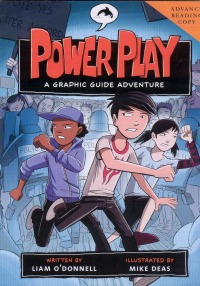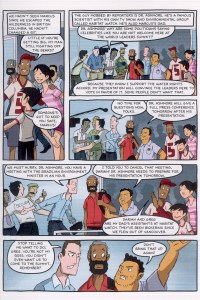| ________________
CM . . .
. Volume XVII Number 19. . . .January 21, 2011 
 |
Power Play. (A Graphic Guide Adventure).
Liam O'Donnell. Illustrated by Mike Deas.
Victoria, BC: Orca, 2011.
64 pp., pbk., $9.95.
ISBN 978-1-55469-069-5.
Subject Headings:
World politics-Comic books, strips, etc.-Juvenile fiction.
Graphic Novels.
Grades 3-8 / Ages 8-13.
Review by Jonine Bergen.
** /4
Reviewed from Advance Reading Copy.
|
| |
|

excerpt:
People have different ideas on the best way to run a country. The political spectrum organizes these ideas into left, right, or center.
People on the left side of the spectrum believe the government is responsible for the well-being of all its citizens. A government should be in charge of hospitals, school and roads, so that all citizens, rich and poor, can use them.
People on the right side of the spectrum believe in a smaller role for the government. Private companies do a better job running hospitals, schools and roads. I should be able to buy the best services available.
People in the center believe in a balance of left and right. The government should take care of all its citizens. Private companies and the government should work together to run hospitals, schools and roads.
Power Play is the next instalment of Liam O'Donnell's and Mike Deas's successful "Graphic Guide Adventure" series. This time, Devin and Nadia team up with some old friends to solve a murder and protect access to the world's water supply while teaching the reader about the complex and murky world of politics.
Nadia and her brother Devin are attending the World Leader's Summit because Nadia won a job organizing the youth summit that is running concurrently. At the Summit, they meet up with their friend, Marcus, who is accompanying his famous father, Dr. Ashmore. When Dr. Ashmore's luggage is slashed, it quickly becomes apparent that someone does not want him to speak in favour of the water rights accord at the Summit. Things get even more complicated when his assistant dies. Was it an accident or murder? Devon, Nadia, and Marcus join forces with Bounce and Pema to foil the bad-guys and solve the case. Along the way, the reader is introduced to explanations of democracy, the political spectrum, civil disobedience, the UN, WHO, and WTO. They also meet the Raging Grannies and run amuck with protestors whom Nadia describes as "a bunch of busybodies who have nothing better to do than upset the democratic process."
The partnership of O'Donnell and Deas continues to excel at explaining complex ideas in a simplified manner and at an appropriate level for students to understand. However, in Power Play, the duo has tried to wrap the plot around too many informational asides which results in a stuttering narrative. The plot is carried by conversations between the characters; this does not interpret well visually. Illustrations in graphic novels should advance the plot with the text and provide clues as to the emotions and nuances in characters. Although Deas valiantly tries to provide visual clues to the rapid pace of the text, in the end, the text does not support the visual nature of a graphic novel.
 Further, the number of characters and plotlines being juggled by O'Donnell is cumbersome and splits the attention of the reader. There are too many secondary characters jockeying for time in the narrative. Devin, Bounce, and Pema are following Wiley, an old nemisis, and his involvement with a big corporation. Nadia and Marcus are pursuing the leads surrounding Farrin and Greg. In the background is the setting of the Summit and the water rights accord championed by Dr. Ashmore. It should be noted that, if the reader is familiar with the other books in this series, many of the issues caused by trying to keep track of so many new characters would be alleviated. But, for the newcomer to the series, the variety will be dizzying. Without the background provided by prior contact with the characters, one will ultimately find the action lacking credibility. Jumping back and forth between the two sets of characters and their activities makes it difficult for the reader to know on what to focus. As a result, the tempo is slower than what is required for a good mystery.
Further, the number of characters and plotlines being juggled by O'Donnell is cumbersome and splits the attention of the reader. There are too many secondary characters jockeying for time in the narrative. Devin, Bounce, and Pema are following Wiley, an old nemisis, and his involvement with a big corporation. Nadia and Marcus are pursuing the leads surrounding Farrin and Greg. In the background is the setting of the Summit and the water rights accord championed by Dr. Ashmore. It should be noted that, if the reader is familiar with the other books in this series, many of the issues caused by trying to keep track of so many new characters would be alleviated. But, for the newcomer to the series, the variety will be dizzying. Without the background provided by prior contact with the characters, one will ultimately find the action lacking credibility. Jumping back and forth between the two sets of characters and their activities makes it difficult for the reader to know on what to focus. As a result, the tempo is slower than what is required for a good mystery.
Power Play has all the characteristics that should make it an excellent story; a strong author and illustrator, it is part of a successful series, has known characters, it contains an interesting mystery, and it is full political intrigue. In the final analysis, the plot is not strong enough to hold all the pieces together. There are simply too many characters and informational asides, too many subplots and intrigues, and too much politics for this medium to handle at this level. This puzzle cannot be put together successfully because there are too many pieces to fit into the defined space.
If you have already purchased other books in the "Graphic Guide Adventure" series, Power Play may be a worthwhile addition. However, if you are new to the series, it may be advisable to acquire some of the earlier instalments prior to reading this one.
Recommended with reservations.
Jonine Bergen is a librarian in Winnipeg, MB.

To comment
on this title or this review, send mail to cm@umanitoba.ca.
Copyright © the Manitoba Library Association. Reproduction for personal
use is permitted only if this copyright notice is maintained. Any
other reproduction is prohibited without permission.
NEXT REVIEW |
TABLE OF CONTENTS FOR THIS ISSUE
- January 21, 2011.
AUTHORS |
TITLES |
MEDIA REVIEWS |
PROFILES |
BACK ISSUES |
SEARCH |
CMARCHIVE |
HOME |

 Further, the number of characters and plotlines being juggled by O'Donnell is cumbersome and splits the attention of the reader. There are too many secondary characters jockeying for time in the narrative. Devin, Bounce, and Pema are following Wiley, an old nemisis, and his involvement with a big corporation. Nadia and Marcus are pursuing the leads surrounding Farrin and Greg. In the background is the setting of the Summit and the water rights accord championed by Dr. Ashmore. It should be noted that, if the reader is familiar with the other books in this series, many of the issues caused by trying to keep track of so many new characters would be alleviated. But, for the newcomer to the series, the variety will be dizzying. Without the background provided by prior contact with the characters, one will ultimately find the action lacking credibility. Jumping back and forth between the two sets of characters and their activities makes it difficult for the reader to know on what to focus. As a result, the tempo is slower than what is required for a good mystery.
Further, the number of characters and plotlines being juggled by O'Donnell is cumbersome and splits the attention of the reader. There are too many secondary characters jockeying for time in the narrative. Devin, Bounce, and Pema are following Wiley, an old nemisis, and his involvement with a big corporation. Nadia and Marcus are pursuing the leads surrounding Farrin and Greg. In the background is the setting of the Summit and the water rights accord championed by Dr. Ashmore. It should be noted that, if the reader is familiar with the other books in this series, many of the issues caused by trying to keep track of so many new characters would be alleviated. But, for the newcomer to the series, the variety will be dizzying. Without the background provided by prior contact with the characters, one will ultimately find the action lacking credibility. Jumping back and forth between the two sets of characters and their activities makes it difficult for the reader to know on what to focus. As a result, the tempo is slower than what is required for a good mystery.